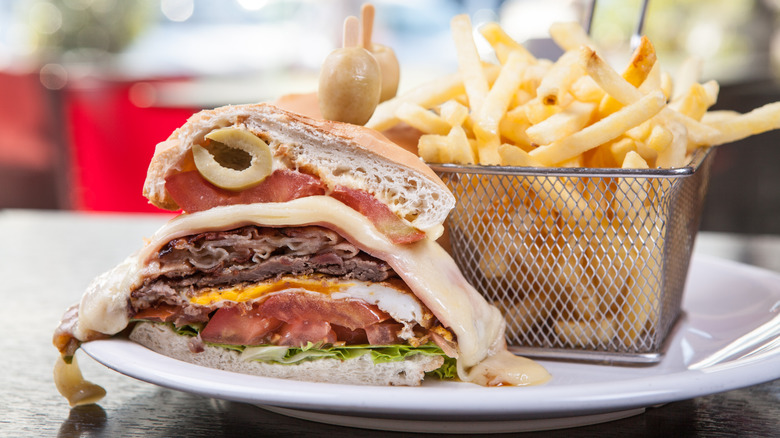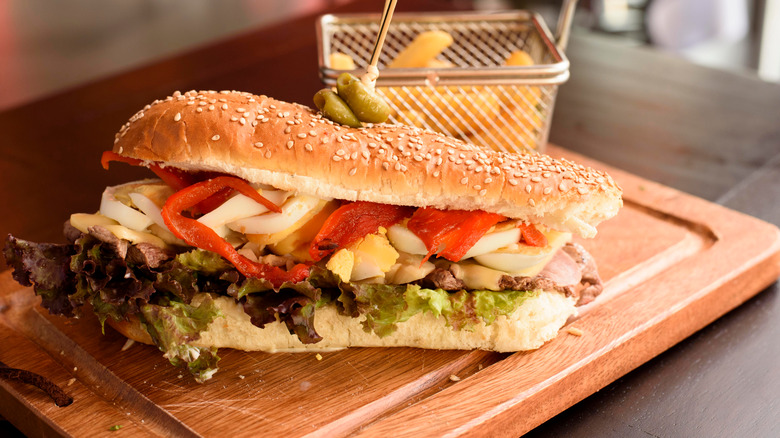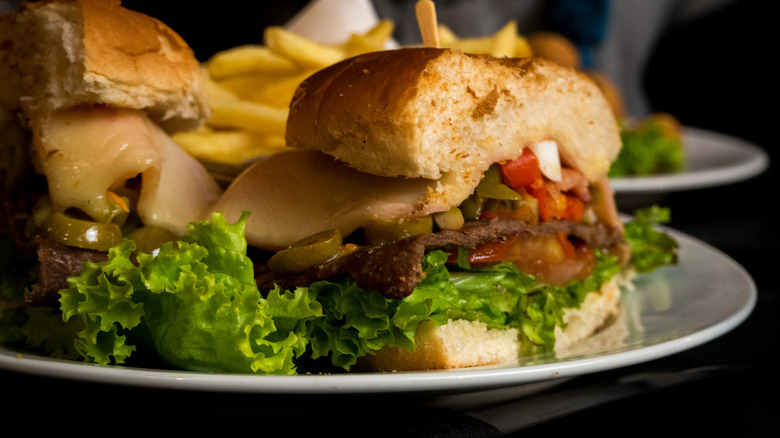Chivito Is The Small, Thinly-Sliced Steak Sandwich You Should Know
Imagine if a Cuban sandwich and muffuletta had a baby: Say, a generous concoction featuring the likes of thinly-sliced grilled steak placed on top of a lightly-toasted bun brushed with mayonnaise, then topped with ham, melted mozzarella cheese, tomato, bacon, fried egg, olives, and lettuce. If that sounds like a dream come true it's because it is: We just described a chivito (roughly translated as "little goat"), the mighty sandwich that is one of Uruguay's national dishes.
If you make a chivito — and for goodness sake, let nothing stop you! — be prepared for the sandwich, that is as central to Uruguayans' identity as the hamburger is to Americans, to be a meal unto itself. And beyond that, once you've learned the basics of the sandwich, you can make it your own with whatever toppings you like, from red beets to relish and mushrooms to roasted peppers.
A brief history of chivito
It might sound odd that a sandwich named "the little goat" is actually made with beef. As you might imagine, there's an origin story. The sandwich was created by accident one day in 1946 when an Argentinian woman walked into the El Mejillón restaurant in Uruguay's southern town of Punta del Este and ordered a sandwich made with chivito (Argentinians call barbecued baby goat, or kid, "chivito," and that's the meat she expected to eat). The proprietor had none, however, and instead substituted churrasco – a deliriously good, thinly-sliced, and flash-grilled skirt steak — in a sandwich quickly made with tomato, lettuce, and mayonnaise. History was made.
As word and subsequent fame of the sandwich spread (both being basically instantaneous), the chivito became not only a national institution but subject to all manner of regional variation: Depending largely on what part of Uruguay you're in, the sandwich you order may be presented as a mile-high monstrosity or a little guy not much bigger than a slider. In some places, you'll get a breadless platter just to maximize its number of ingredients. More on that later.
How to create a basic chivito
As we've mentioned, the traditional chivito recipe begins with churrasco. You can, of course, make whatever kind of beef you want: sirloin, flank, skirt, ribeyes — pretty much whatever kind of beef suits your fancy will work beautifully. Slice the steak very thin and, if you like, pound it out to be even more tender. Next, sear it quickly over high heat, either in a skillet or on the grill.
Your bread should be soft with a hard crust, like a Kaiser roll of ciabatta, and lightly toasted. There is near-universal agreement on subsequently adding mayonnaise, sliced tomato, and melted mozzarella cheese. This will, in essence, be a reproduction of the first chivito ever made way back when in El Mejillón. Unsurprisingly, the sandwich has evolved: Modern chivito recipes feature bacon (or pancetta), ham, a fried egg, and lettuce (It's a good idea to cook all these items in the same pan, for obvious and flavorful reasons). But many don't stop there.
El chivito variations
Now that you've got the basic chivito down, it's time to let your imagination run wild. Try making what's called a "chivito canadiense" with Canadian bacon. Consider adding slices of Vidalia onion, or red beets, to the layers. Many chivito recipes feature sliced green or black olives, relish, olive oil, pickles, and oregano. You get the idea. Just as in Uruguay , your chivito can either be a monolithic meal, a tasty mid-afternoon snack, or what is known as "chivito al plato" — essentially protein on a plate without the bread.
So there you have it. The "little goat" that's had a huge effect on the way the world eats. A good chivito is easily the match of even well-established creations like the Philly cheesesteak or Reuben — and for good reason. At its heart, the chivito is the combination of simple, honest ingredients that combine to make the whole greater than the sum of its parts. But don't take our word for it.



